Project V1.5: Organizational Development Plan and Strategies
VerifiedAdded on 2022/11/17
|8
|1437
|319
Project
AI Summary
This project, titled Project V1.5, provides a comprehensive overview of organizational development plans. It begins by outlining the creation of a strategic action plan, emphasizing the importance of effective communication, delegation of responsibilities, and data-driven monitoring for progress assessment. The project then delves into change management, highlighting the need for a strategic plan to achieve cultural shifts within an organization. It emphasizes the crucial role of communication in the development phase. The project further discusses the implementation of development plans, addressing challenges such as resistance to change and the importance of creating a positive environment through team development activities and conflict resolution strategies. Modifications due to technology, legislation, or business practice changes are also addressed, stressing the need for feedback, progress monitoring, and adaptability in the development plan. The project also includes references to support the discussed concepts.
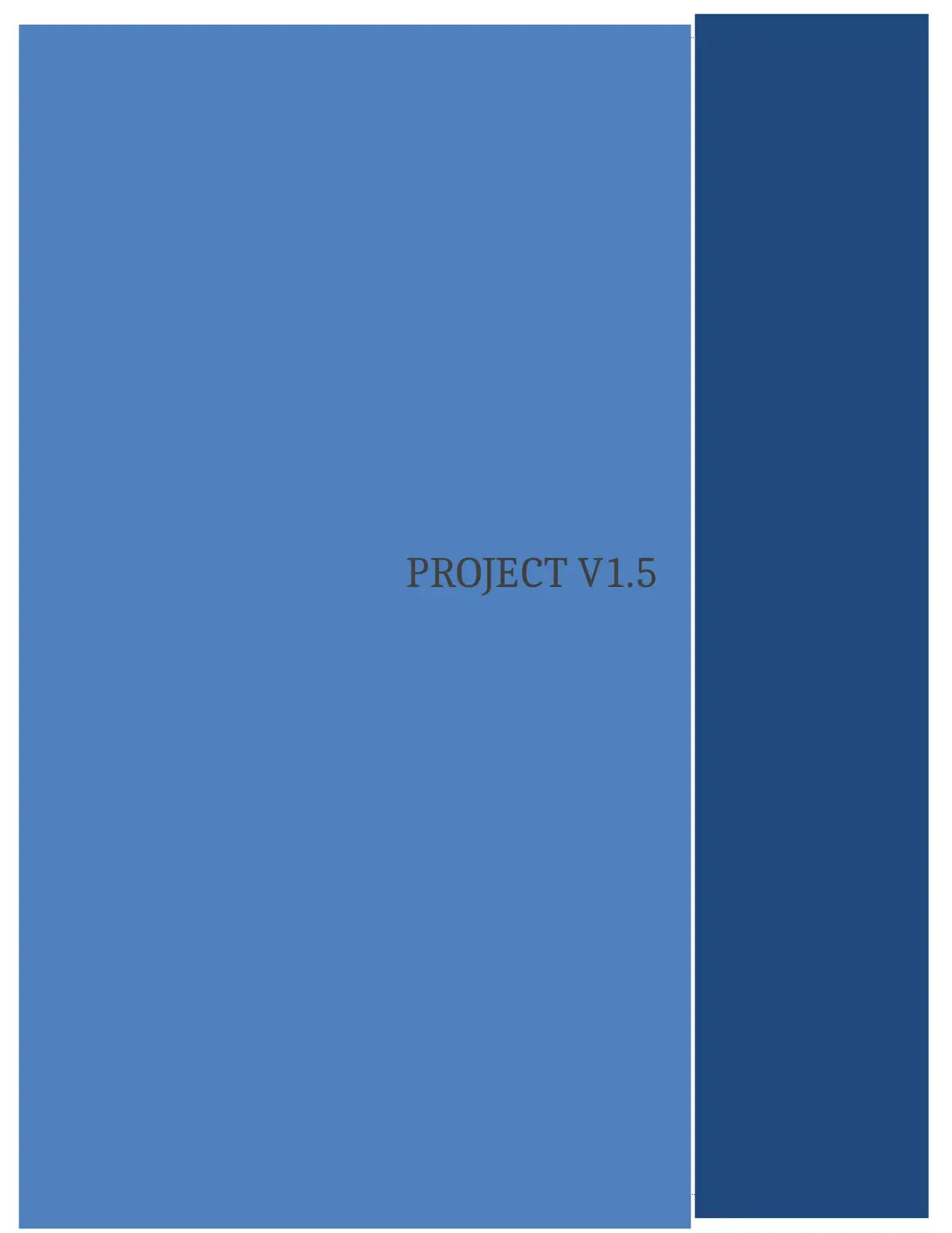
PROJECT V1.5
Paraphrase This Document
Need a fresh take? Get an instant paraphrase of this document with our AI Paraphraser
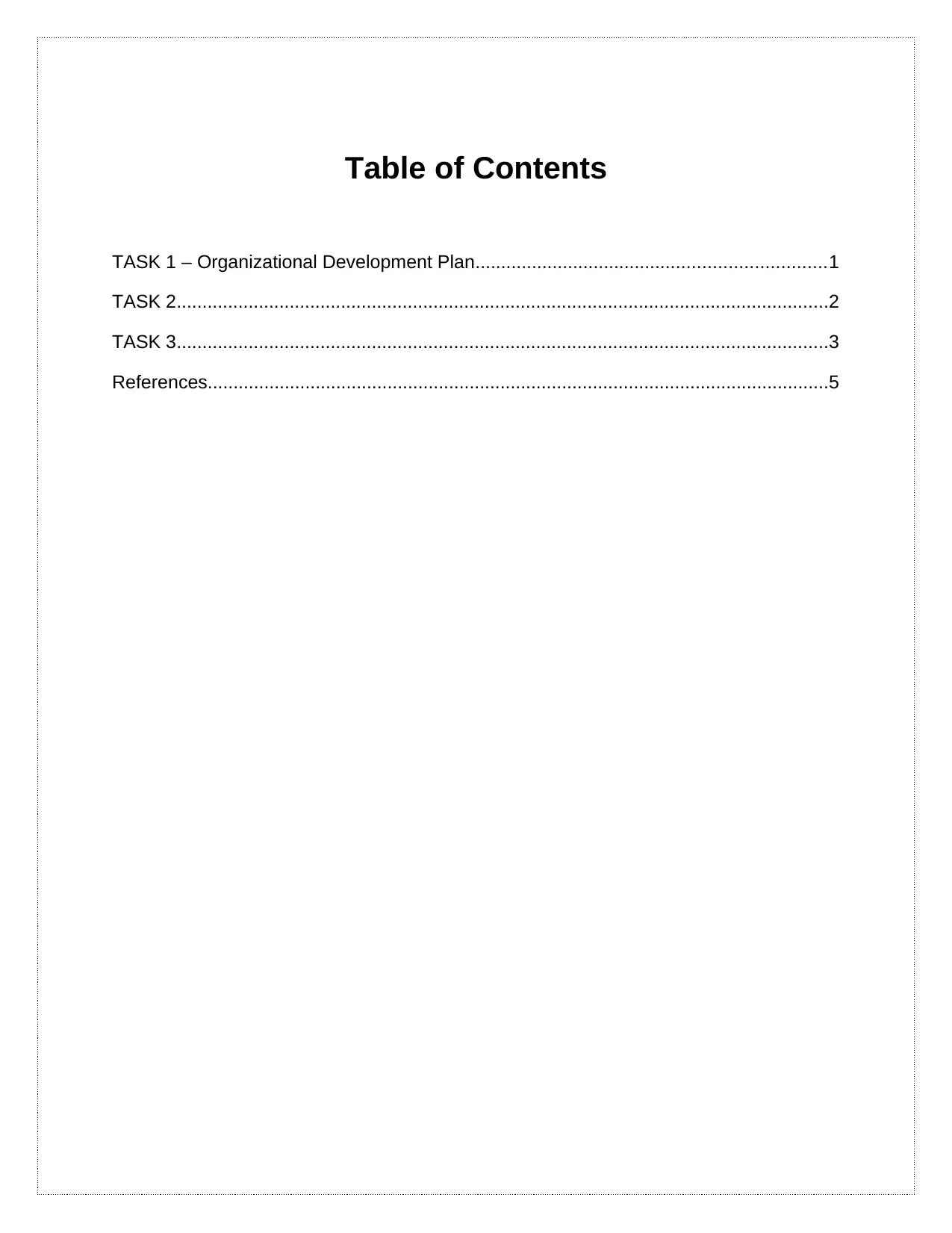
Table of Contents
TASK 1 – Organizational Development Plan....................................................................1
TASK 2...............................................................................................................................2
TASK 3...............................................................................................................................3
References.........................................................................................................................5
TASK 1 – Organizational Development Plan....................................................................1
TASK 2...............................................................................................................................2
TASK 3...............................................................................................................................3
References.........................................................................................................................5
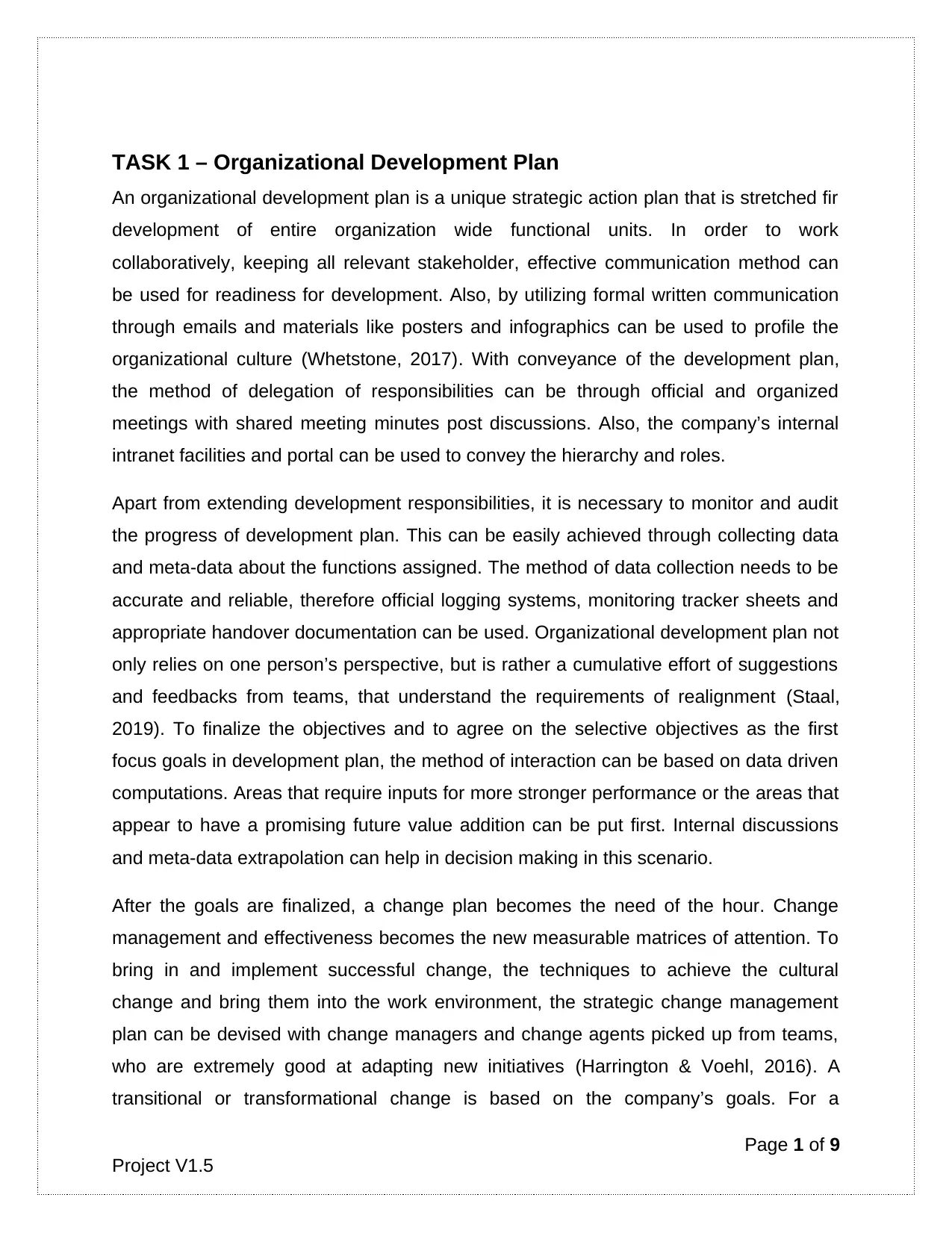
TASK 1 – Organizational Development Plan
An organizational development plan is a unique strategic action plan that is stretched fir
development of entire organization wide functional units. In order to work
collaboratively, keeping all relevant stakeholder, effective communication method can
be used for readiness for development. Also, by utilizing formal written communication
through emails and materials like posters and infographics can be used to profile the
organizational culture (Whetstone, 2017). With conveyance of the development plan,
the method of delegation of responsibilities can be through official and organized
meetings with shared meeting minutes post discussions. Also, the company’s internal
intranet facilities and portal can be used to convey the hierarchy and roles.
Apart from extending development responsibilities, it is necessary to monitor and audit
the progress of development plan. This can be easily achieved through collecting data
and meta-data about the functions assigned. The method of data collection needs to be
accurate and reliable, therefore official logging systems, monitoring tracker sheets and
appropriate handover documentation can be used. Organizational development plan not
only relies on one person’s perspective, but is rather a cumulative effort of suggestions
and feedbacks from teams, that understand the requirements of realignment (Staal,
2019). To finalize the objectives and to agree on the selective objectives as the first
focus goals in development plan, the method of interaction can be based on data driven
computations. Areas that require inputs for more stronger performance or the areas that
appear to have a promising future value addition can be put first. Internal discussions
and meta-data extrapolation can help in decision making in this scenario.
After the goals are finalized, a change plan becomes the need of the hour. Change
management and effectiveness becomes the new measurable matrices of attention. To
bring in and implement successful change, the techniques to achieve the cultural
change and bring them into the work environment, the strategic change management
plan can be devised with change managers and change agents picked up from teams,
who are extremely good at adapting new initiatives (Harrington & Voehl, 2016). A
transitional or transformational change is based on the company’s goals. For a
Page 1 of 9
Project V1.5
An organizational development plan is a unique strategic action plan that is stretched fir
development of entire organization wide functional units. In order to work
collaboratively, keeping all relevant stakeholder, effective communication method can
be used for readiness for development. Also, by utilizing formal written communication
through emails and materials like posters and infographics can be used to profile the
organizational culture (Whetstone, 2017). With conveyance of the development plan,
the method of delegation of responsibilities can be through official and organized
meetings with shared meeting minutes post discussions. Also, the company’s internal
intranet facilities and portal can be used to convey the hierarchy and roles.
Apart from extending development responsibilities, it is necessary to monitor and audit
the progress of development plan. This can be easily achieved through collecting data
and meta-data about the functions assigned. The method of data collection needs to be
accurate and reliable, therefore official logging systems, monitoring tracker sheets and
appropriate handover documentation can be used. Organizational development plan not
only relies on one person’s perspective, but is rather a cumulative effort of suggestions
and feedbacks from teams, that understand the requirements of realignment (Staal,
2019). To finalize the objectives and to agree on the selective objectives as the first
focus goals in development plan, the method of interaction can be based on data driven
computations. Areas that require inputs for more stronger performance or the areas that
appear to have a promising future value addition can be put first. Internal discussions
and meta-data extrapolation can help in decision making in this scenario.
After the goals are finalized, a change plan becomes the need of the hour. Change
management and effectiveness becomes the new measurable matrices of attention. To
bring in and implement successful change, the techniques to achieve the cultural
change and bring them into the work environment, the strategic change management
plan can be devised with change managers and change agents picked up from teams,
who are extremely good at adapting new initiatives (Harrington & Voehl, 2016). A
transitional or transformational change is based on the company’s goals. For a
Page 1 of 9
Project V1.5
⊘ This is a preview!⊘
Do you want full access?
Subscribe today to unlock all pages.

Trusted by 1+ million students worldwide
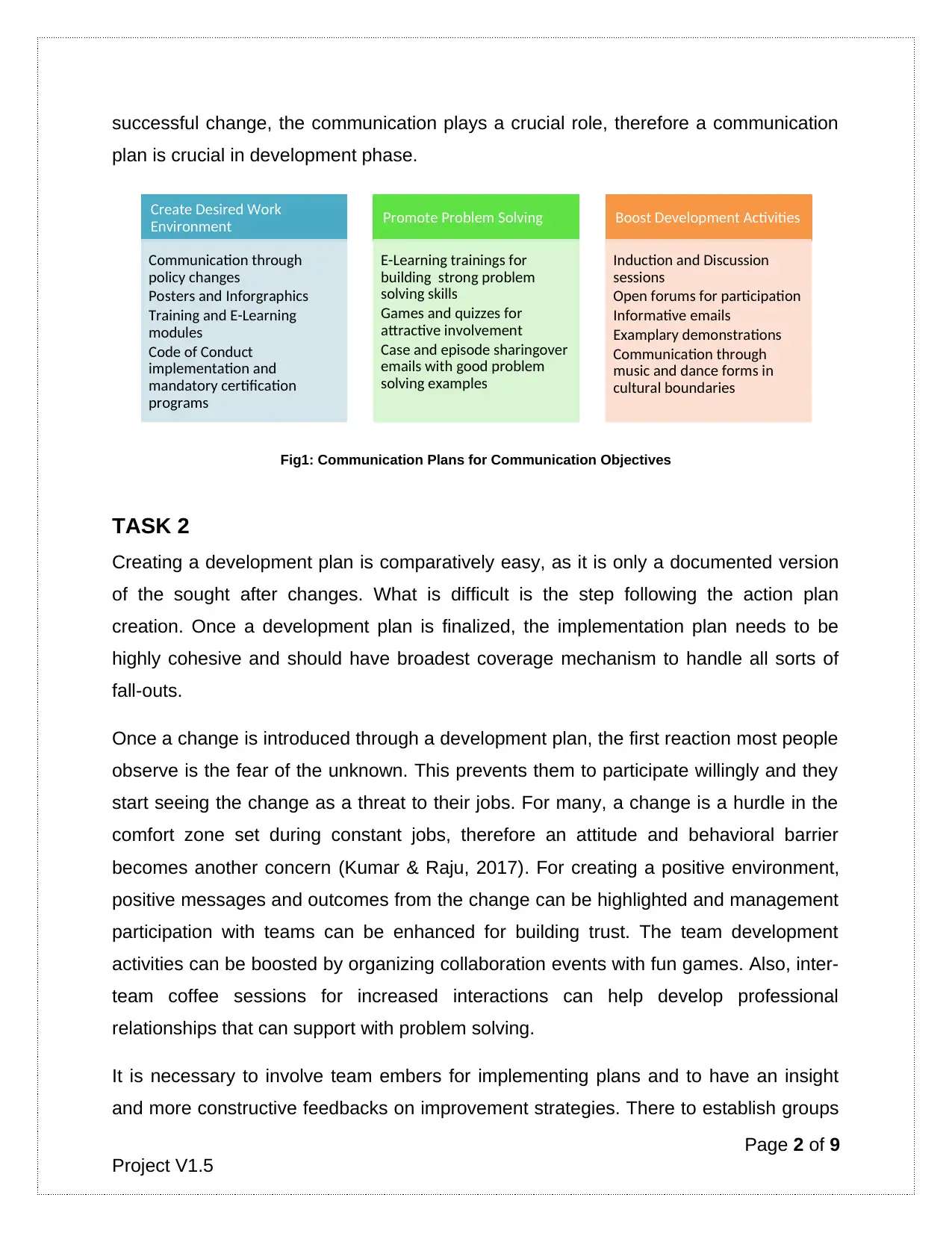
successful change, the communication plays a crucial role, therefore a communication
plan is crucial in development phase.
Fig1: Communication Plans for Communication Objectives
TASK 2
Creating a development plan is comparatively easy, as it is only a documented version
of the sought after changes. What is difficult is the step following the action plan
creation. Once a development plan is finalized, the implementation plan needs to be
highly cohesive and should have broadest coverage mechanism to handle all sorts of
fall-outs.
Once a change is introduced through a development plan, the first reaction most people
observe is the fear of the unknown. This prevents them to participate willingly and they
start seeing the change as a threat to their jobs. For many, a change is a hurdle in the
comfort zone set during constant jobs, therefore an attitude and behavioral barrier
becomes another concern (Kumar & Raju, 2017). For creating a positive environment,
positive messages and outcomes from the change can be highlighted and management
participation with teams can be enhanced for building trust. The team development
activities can be boosted by organizing collaboration events with fun games. Also, inter-
team coffee sessions for increased interactions can help develop professional
relationships that can support with problem solving.
It is necessary to involve team embers for implementing plans and to have an insight
and more constructive feedbacks on improvement strategies. There to establish groups
Page 2 of 9
Project V1.5
Create Desired Work
Environment
Communication through
policy changes
Posters and Inforgraphics
Training and E-Learning
modules
Code of Conduct
implementation and
mandatory certification
programs
Promote Problem Solving
E-Learning trainings for
building strong problem
solving skills
Games and quizzes for
attractive involvement
Case and episode sharingover
emails with good problem
solving examples
Boost Development Activities
Induction and Discussion
sessions
Open forums for participation
Informative emails
Examplary demonstrations
Communication through
music and dance forms in
cultural boundaries
plan is crucial in development phase.
Fig1: Communication Plans for Communication Objectives
TASK 2
Creating a development plan is comparatively easy, as it is only a documented version
of the sought after changes. What is difficult is the step following the action plan
creation. Once a development plan is finalized, the implementation plan needs to be
highly cohesive and should have broadest coverage mechanism to handle all sorts of
fall-outs.
Once a change is introduced through a development plan, the first reaction most people
observe is the fear of the unknown. This prevents them to participate willingly and they
start seeing the change as a threat to their jobs. For many, a change is a hurdle in the
comfort zone set during constant jobs, therefore an attitude and behavioral barrier
becomes another concern (Kumar & Raju, 2017). For creating a positive environment,
positive messages and outcomes from the change can be highlighted and management
participation with teams can be enhanced for building trust. The team development
activities can be boosted by organizing collaboration events with fun games. Also, inter-
team coffee sessions for increased interactions can help develop professional
relationships that can support with problem solving.
It is necessary to involve team embers for implementing plans and to have an insight
and more constructive feedbacks on improvement strategies. There to establish groups
Page 2 of 9
Project V1.5
Create Desired Work
Environment
Communication through
policy changes
Posters and Inforgraphics
Training and E-Learning
modules
Code of Conduct
implementation and
mandatory certification
programs
Promote Problem Solving
E-Learning trainings for
building strong problem
solving skills
Games and quizzes for
attractive involvement
Case and episode sharingover
emails with good problem
solving examples
Boost Development Activities
Induction and Discussion
sessions
Open forums for participation
Informative emails
Examplary demonstrations
Communication through
music and dance forms in
cultural boundaries
Paraphrase This Document
Need a fresh take? Get an instant paraphrase of this document with our AI Paraphraser
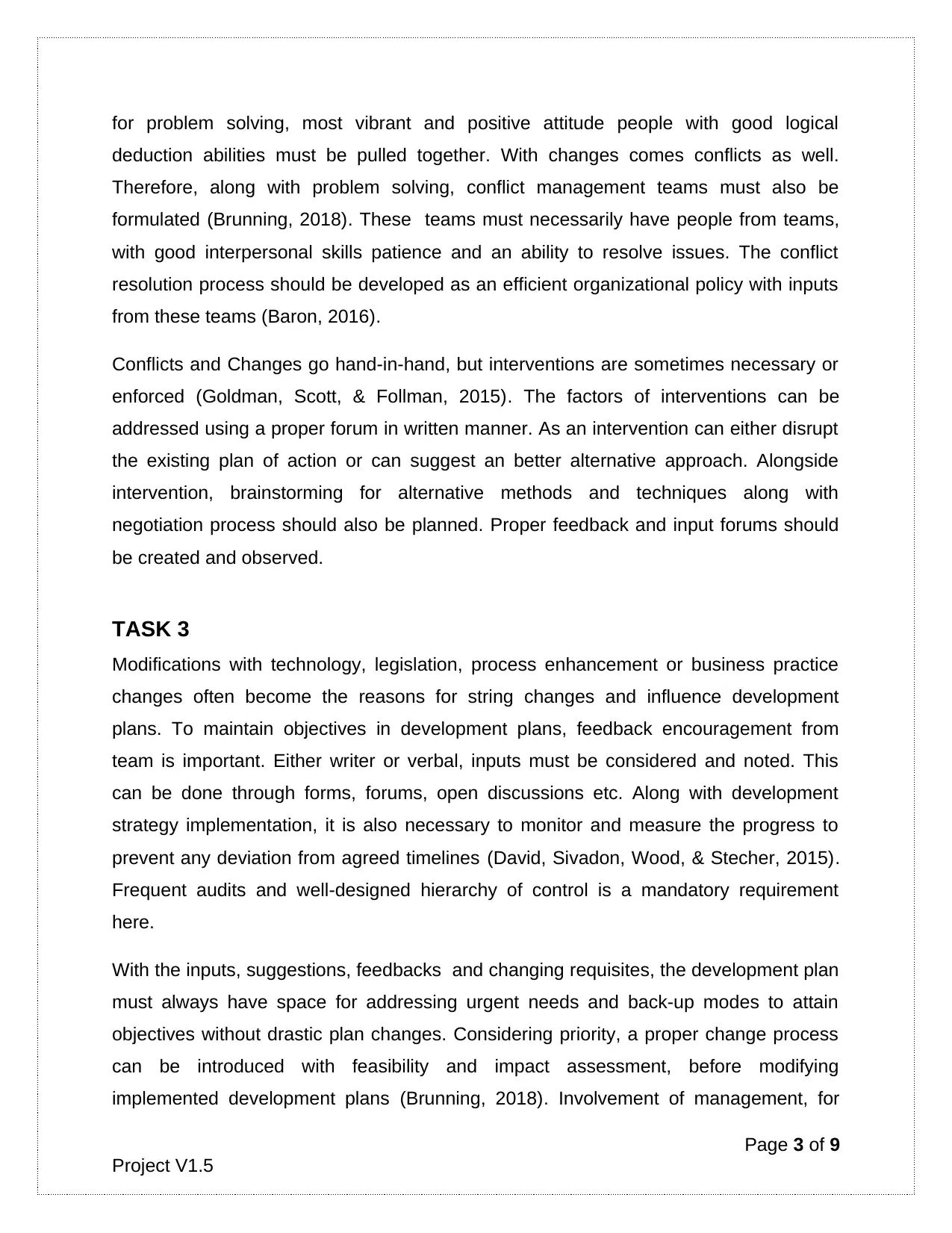
for problem solving, most vibrant and positive attitude people with good logical
deduction abilities must be pulled together. With changes comes conflicts as well.
Therefore, along with problem solving, conflict management teams must also be
formulated (Brunning, 2018). These teams must necessarily have people from teams,
with good interpersonal skills patience and an ability to resolve issues. The conflict
resolution process should be developed as an efficient organizational policy with inputs
from these teams (Baron, 2016).
Conflicts and Changes go hand-in-hand, but interventions are sometimes necessary or
enforced (Goldman, Scott, & Follman, 2015). The factors of interventions can be
addressed using a proper forum in written manner. As an intervention can either disrupt
the existing plan of action or can suggest an better alternative approach. Alongside
intervention, brainstorming for alternative methods and techniques along with
negotiation process should also be planned. Proper feedback and input forums should
be created and observed.
TASK 3
Modifications with technology, legislation, process enhancement or business practice
changes often become the reasons for string changes and influence development
plans. To maintain objectives in development plans, feedback encouragement from
team is important. Either writer or verbal, inputs must be considered and noted. This
can be done through forms, forums, open discussions etc. Along with development
strategy implementation, it is also necessary to monitor and measure the progress to
prevent any deviation from agreed timelines (David, Sivadon, Wood, & Stecher, 2015).
Frequent audits and well-designed hierarchy of control is a mandatory requirement
here.
With the inputs, suggestions, feedbacks and changing requisites, the development plan
must always have space for addressing urgent needs and back-up modes to attain
objectives without drastic plan changes. Considering priority, a proper change process
can be introduced with feasibility and impact assessment, before modifying
implemented development plans (Brunning, 2018). Involvement of management, for
Page 3 of 9
Project V1.5
deduction abilities must be pulled together. With changes comes conflicts as well.
Therefore, along with problem solving, conflict management teams must also be
formulated (Brunning, 2018). These teams must necessarily have people from teams,
with good interpersonal skills patience and an ability to resolve issues. The conflict
resolution process should be developed as an efficient organizational policy with inputs
from these teams (Baron, 2016).
Conflicts and Changes go hand-in-hand, but interventions are sometimes necessary or
enforced (Goldman, Scott, & Follman, 2015). The factors of interventions can be
addressed using a proper forum in written manner. As an intervention can either disrupt
the existing plan of action or can suggest an better alternative approach. Alongside
intervention, brainstorming for alternative methods and techniques along with
negotiation process should also be planned. Proper feedback and input forums should
be created and observed.
TASK 3
Modifications with technology, legislation, process enhancement or business practice
changes often become the reasons for string changes and influence development
plans. To maintain objectives in development plans, feedback encouragement from
team is important. Either writer or verbal, inputs must be considered and noted. This
can be done through forms, forums, open discussions etc. Along with development
strategy implementation, it is also necessary to monitor and measure the progress to
prevent any deviation from agreed timelines (David, Sivadon, Wood, & Stecher, 2015).
Frequent audits and well-designed hierarchy of control is a mandatory requirement
here.
With the inputs, suggestions, feedbacks and changing requisites, the development plan
must always have space for addressing urgent needs and back-up modes to attain
objectives without drastic plan changes. Considering priority, a proper change process
can be introduced with feasibility and impact assessment, before modifying
implemented development plans (Brunning, 2018). Involvement of management, for
Page 3 of 9
Project V1.5
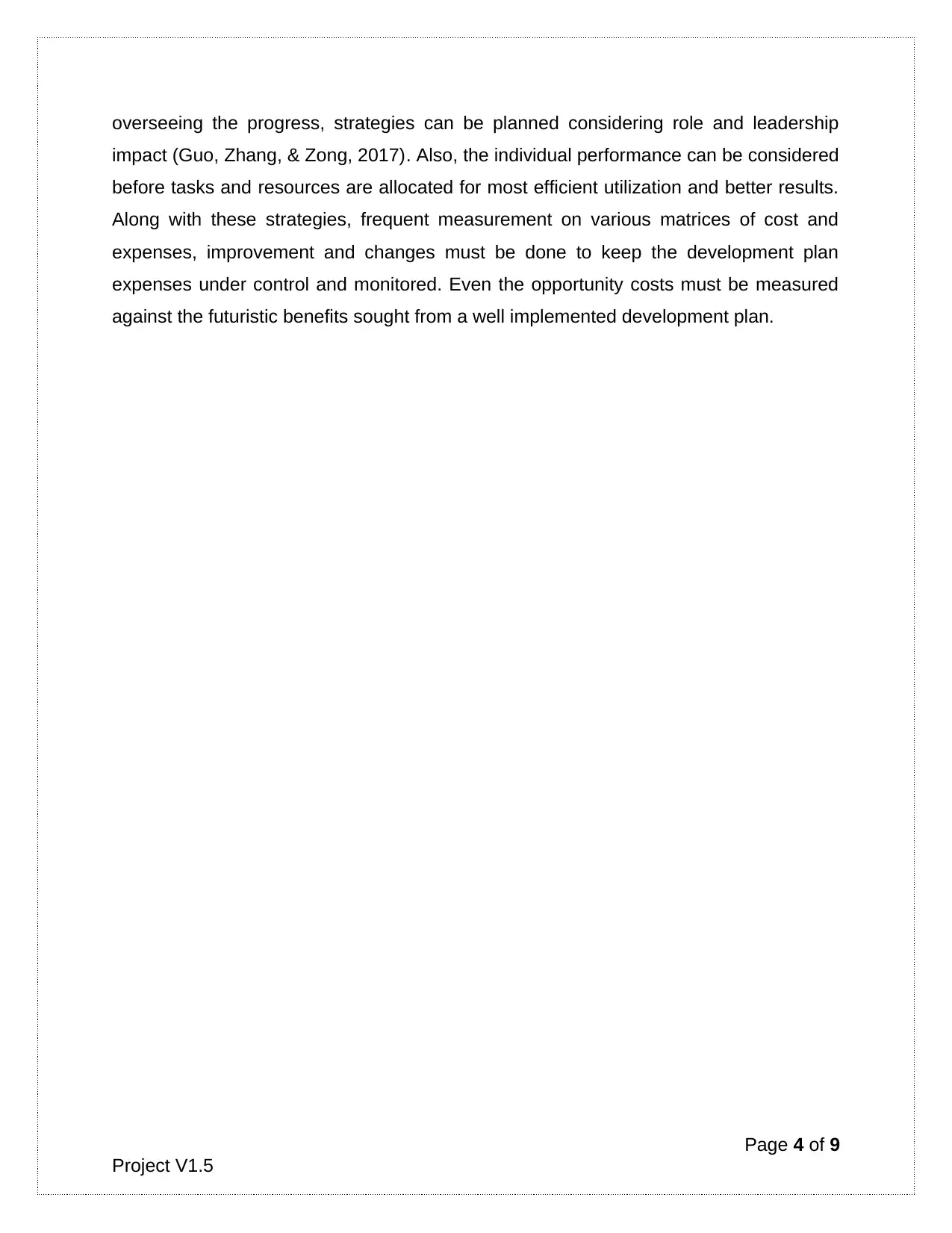
overseeing the progress, strategies can be planned considering role and leadership
impact (Guo, Zhang, & Zong, 2017). Also, the individual performance can be considered
before tasks and resources are allocated for most efficient utilization and better results.
Along with these strategies, frequent measurement on various matrices of cost and
expenses, improvement and changes must be done to keep the development plan
expenses under control and monitored. Even the opportunity costs must be measured
against the futuristic benefits sought from a well implemented development plan.
Page 4 of 9
Project V1.5
impact (Guo, Zhang, & Zong, 2017). Also, the individual performance can be considered
before tasks and resources are allocated for most efficient utilization and better results.
Along with these strategies, frequent measurement on various matrices of cost and
expenses, improvement and changes must be done to keep the development plan
expenses under control and monitored. Even the opportunity costs must be measured
against the futuristic benefits sought from a well implemented development plan.
Page 4 of 9
Project V1.5
⊘ This is a preview!⊘
Do you want full access?
Subscribe today to unlock all pages.

Trusted by 1+ million students worldwide
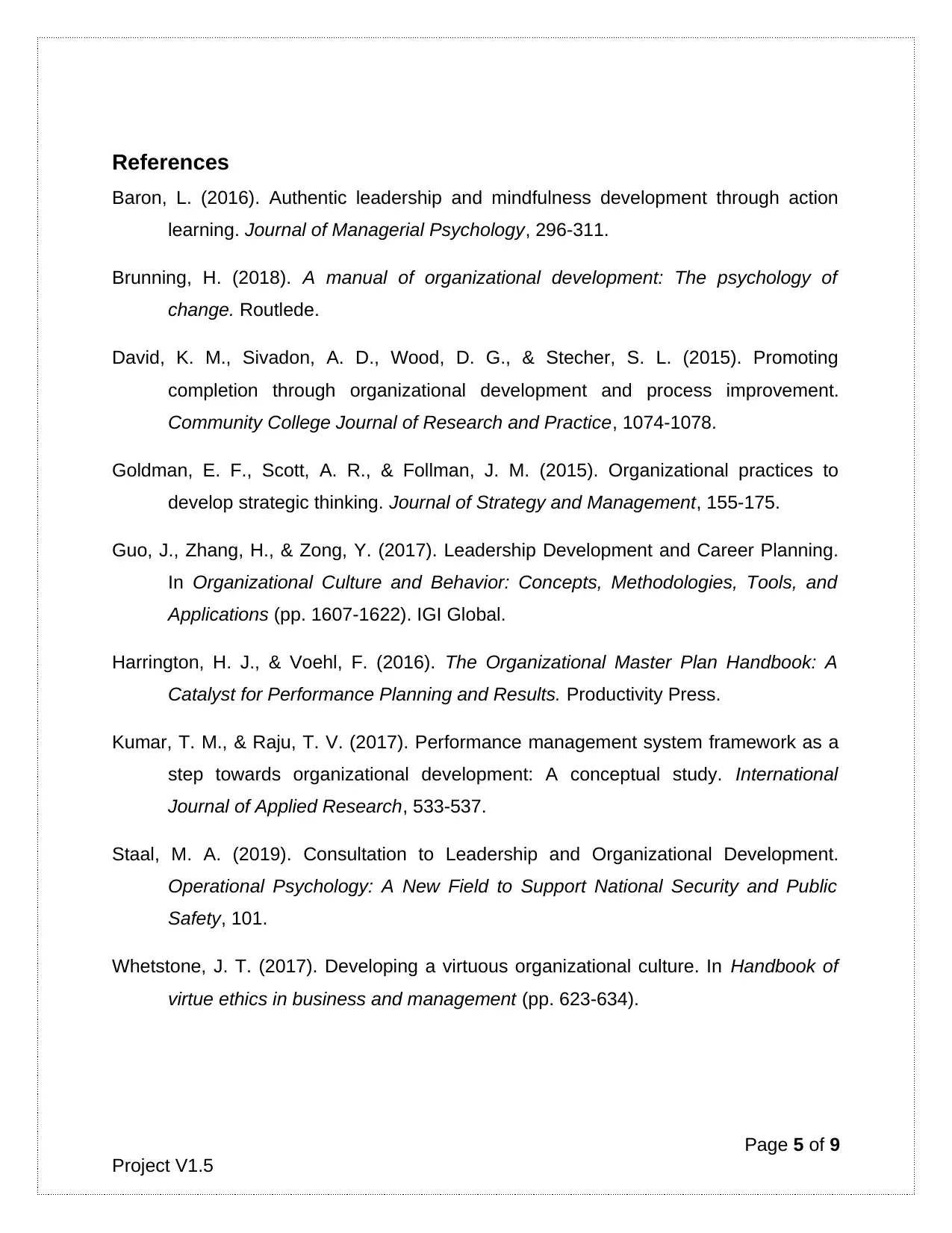
References
Baron, L. (2016). Authentic leadership and mindfulness development through action
learning. Journal of Managerial Psychology, 296-311.
Brunning, H. (2018). A manual of organizational development: The psychology of
change. Routlede.
David, K. M., Sivadon, A. D., Wood, D. G., & Stecher, S. L. (2015). Promoting
completion through organizational development and process improvement.
Community College Journal of Research and Practice, 1074-1078.
Goldman, E. F., Scott, A. R., & Follman, J. M. (2015). Organizational practices to
develop strategic thinking. Journal of Strategy and Management, 155-175.
Guo, J., Zhang, H., & Zong, Y. (2017). Leadership Development and Career Planning.
In Organizational Culture and Behavior: Concepts, Methodologies, Tools, and
Applications (pp. 1607-1622). IGI Global.
Harrington, H. J., & Voehl, F. (2016). The Organizational Master Plan Handbook: A
Catalyst for Performance Planning and Results. Productivity Press.
Kumar, T. M., & Raju, T. V. (2017). Performance management system framework as a
step towards organizational development: A conceptual study. International
Journal of Applied Research, 533-537.
Staal, M. A. (2019). Consultation to Leadership and Organizational Development.
Operational Psychology: A New Field to Support National Security and Public
Safety, 101.
Whetstone, J. T. (2017). Developing a virtuous organizational culture. In Handbook of
virtue ethics in business and management (pp. 623-634).
Page 5 of 9
Project V1.5
Baron, L. (2016). Authentic leadership and mindfulness development through action
learning. Journal of Managerial Psychology, 296-311.
Brunning, H. (2018). A manual of organizational development: The psychology of
change. Routlede.
David, K. M., Sivadon, A. D., Wood, D. G., & Stecher, S. L. (2015). Promoting
completion through organizational development and process improvement.
Community College Journal of Research and Practice, 1074-1078.
Goldman, E. F., Scott, A. R., & Follman, J. M. (2015). Organizational practices to
develop strategic thinking. Journal of Strategy and Management, 155-175.
Guo, J., Zhang, H., & Zong, Y. (2017). Leadership Development and Career Planning.
In Organizational Culture and Behavior: Concepts, Methodologies, Tools, and
Applications (pp. 1607-1622). IGI Global.
Harrington, H. J., & Voehl, F. (2016). The Organizational Master Plan Handbook: A
Catalyst for Performance Planning and Results. Productivity Press.
Kumar, T. M., & Raju, T. V. (2017). Performance management system framework as a
step towards organizational development: A conceptual study. International
Journal of Applied Research, 533-537.
Staal, M. A. (2019). Consultation to Leadership and Organizational Development.
Operational Psychology: A New Field to Support National Security and Public
Safety, 101.
Whetstone, J. T. (2017). Developing a virtuous organizational culture. In Handbook of
virtue ethics in business and management (pp. 623-634).
Page 5 of 9
Project V1.5
Paraphrase This Document
Need a fresh take? Get an instant paraphrase of this document with our AI Paraphraser

Page 6 of 9
Project V1.5
Project V1.5
1 out of 8
Related Documents
Your All-in-One AI-Powered Toolkit for Academic Success.
+13062052269
info@desklib.com
Available 24*7 on WhatsApp / Email
![[object Object]](/_next/static/media/star-bottom.7253800d.svg)
Unlock your academic potential
Copyright © 2020–2025 A2Z Services. All Rights Reserved. Developed and managed by ZUCOL.





